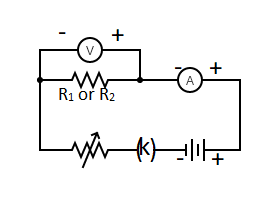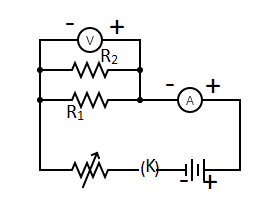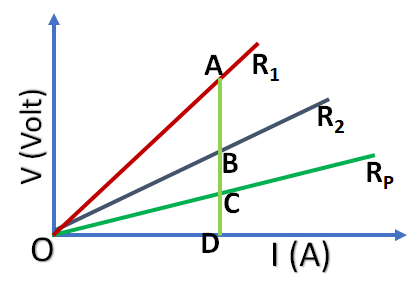Theory
Ohm’s law
The current flowing through a conductor is directly proportional to potential difference across the conductor when temperature and other physical conditions remain constant.
Let V be the potential difference across a conductor and I is the current flowing through it.
V ∝ I
V = IR ……………………….(1)
Where, R is the resistance


Parallel combination of resistances
Let two resistances R1 and R2 are connected in parallel. The equivalent resistance of these two resistances is RP , then
\frac{1}{R_{P}}=\frac{1}{R_{1}}+\frac{1}{R_{2}}
{R_{P}}=\frac{{R_{1}R_{2}}}{{R_{1}+R_{2}}} ……………………….(2)
Procedure (Need not to write in your laboratory notebook)
- Connect all circuit elements as shown in figure for a resistance R1 .
- Vary the resistance of rheostat. Take 8 to 10 reading of ammeter and voltmeter.
- Repeat this procedure for R2 and RP ( parallel combination of R1 and R2 ) .
- Plot the V-I graphs for R1 , R2 and RP .
Results
Table1: Table for determination of resistance
| Resistance | No. of Observation | Voltmeter Reading, V (volt) | Ammeter Reading, I (A) | Resistance, (V/I) (Ω) | Mean Resistance, (Ω) |
| R1 | 1 2 3 4 5 | ||||
| R2 | 1 2 3 4 5 | ||||
| RP | 1 2 3 4 5 |
Determination of resistance from graph
R_{1}=\frac{AD}{OD}
R_{2}=\frac{BD}{OD}
R_{P}=\frac{CD}{OD}

| R1 | R2 | RP | {R_{P}}=\frac{{R_{1}R_{2}}}{{R_{1}+R_{2}}} | |
| Resistance from Table 1 | ||||
| Resistance from graph |
The calculated value of RP is nearly equal to the obtained value from the experiment. So, the parallel law of resistance is valid
Precautions and Discussions
- The connection wires should be cleaned by sand paper.
- The connections should be tight.
- Key should not be closed for long time to avoid excessive heat.
- The ammeter should be connected in series and voltmeter in parallel.
Viva questions with answers for the practical “TO VERIFY LAWS OF RESISTANCES IN PARALLEL BY USING AMMETER AND VOLTMETER”
1. State Ohm’s law.
Answer: The current through a conductor is proportional to the potential difference between the conductor.
2. How voltmeter is connected in a circuit?
Answer: Voltmeter is connected in parallel in a circuit.
3. What is the resistance of an ideal voltmeter?
Answer: Resistance of an ideal voltmeter is infinite.
4. What will happen if a voltmeter is connected in series?
Answer: As the resistance of a voltmeter is high, current will fall in the circuit.
5. What is the resistance of an ideal ammeter?
Answer: The resistance of an ideal ammeter is zero.
6. What is the relation between current and voltage of a conductor?
Answer: V = IR
7. What do you mean by 1A current?
Answer: If 1 coulomb of charge flows through a conductor in 1s, then the current flowing through the conductor is known as 1 ampere current.